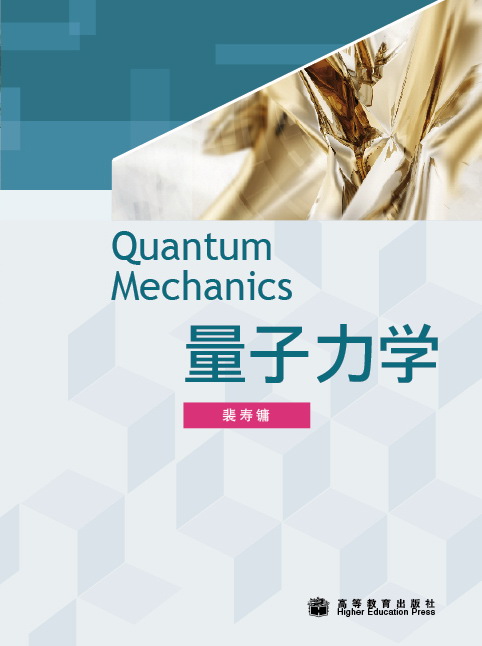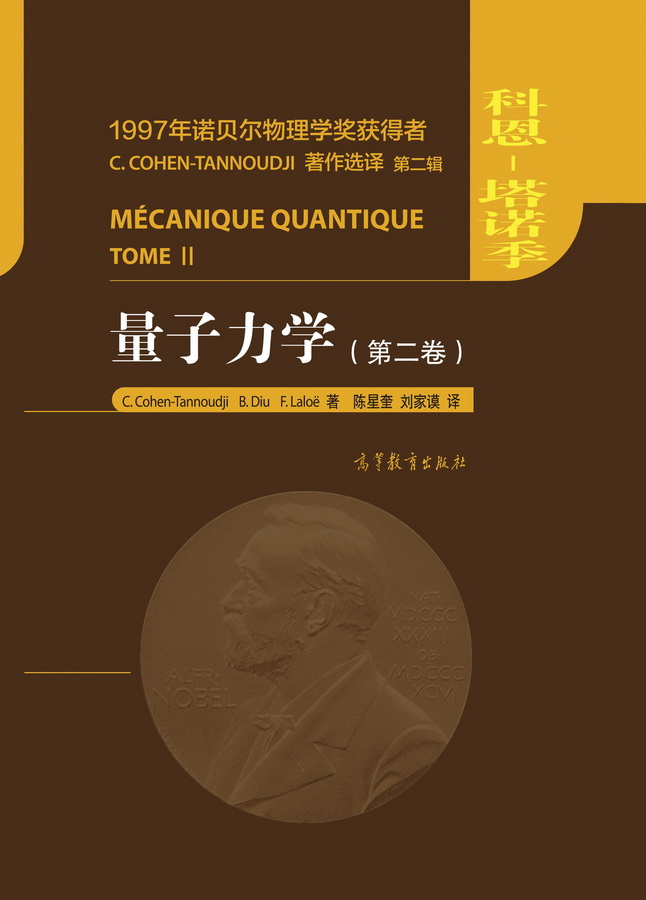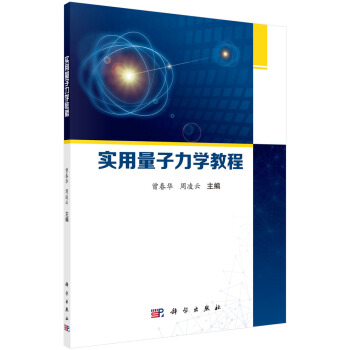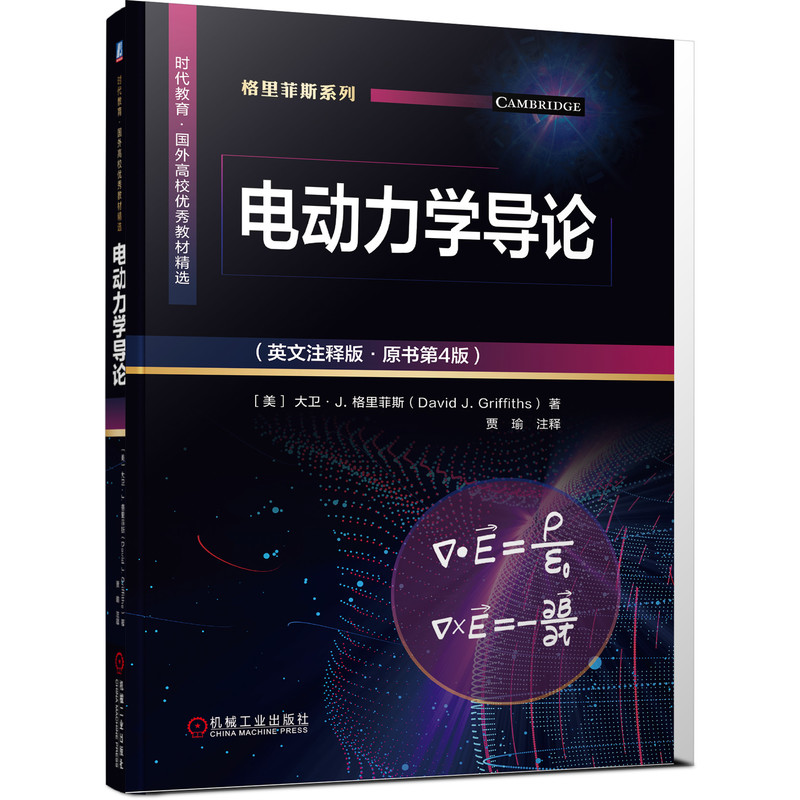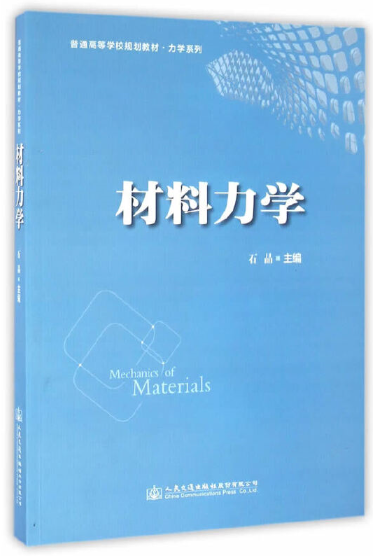量子力学概论(英文注释版·原书第3版) / 时代教育·国外高校优秀教材精选
定价:¥138.00
作者: [美]大卫·J.格里菲斯等
出版时间:2020-09
最新印次日期:2024-1
出版社:机械工业出版社
试读
- 机械工业出版社
- 9787111657514
- 1-2
- 341449
- 48268154-1
- 平装
- 16开
- 2020-09
- 558
- 536
- 理学
- 物理学类
- O
- 物理学
- 本科
内容简介
本书是一本适合本科生学习的量子力学教材,内容分为两部分。第Ⅰ部分为理论,包含波函数、定态薛定谔方程、形式理论、三维空间中的量子力学、全同粒子、对称性和守恒律; 第II部分为应用,包含定态微扰理论、变分原理、WKB近似、散射、量子动力学。本书构思新颖,取材前沿,作者抛开量子力学发展历史的负担,直接从薛定谔方程开始讲授,通过穿插对一些经典问题的讨论,让学生从大量具体问题中体会到量子力学的精髓。本书注重把现代物理前沿引入教学,把量子力学问题扩展到多个前沿的研究领域,如统计物理、固体物理、天体物理、粒子物理、计算物理等。此外,作者着重于交互式的写作,用*一人称“I”以对话式的语言进行叙述,简明扼要,文笔流畅,使人耳目一新。
本书为高校物理专业学生学习量子力学的教材和参考书,也可作为材料、化学等专业学生的教材和相关教师的参考书。
本书为高校物理专业学生学习量子力学的教材和参考书,也可作为材料、化学等专业学生的教材和相关教师的参考书。
目录
目 录
注释者序iii
前言v
第Ⅰ部分 理论1
导 读
第1章波函数 3
1.1薛定谔方程 3
1.2统计诠释 3
1.3几率 8
1.3.1 离散变量8
1.3.2 连续变量11
1.4归一化 14
1.5动量 16
1.6不确定性原理 19
本章习题补充20
导 读
第2章定态薛定谔方程 25
2.1定态 25
2.2无限深方势阱 31
2.3谐振子 39
2.3.1 代数方法40
2.3.2 解析方法48
2.4自由粒子 55
2.5函数势 61
2.5.1 束缚态和散射态61
2.5.2 函数势阱63
2.6有限方势阱70
本章习题补充76
导 读
第3章形式理论91
3.1希尔伯特空间 91
3.2可观测量 94
3.2.1 厄密算符94
3.2.2 定态96
3.3厄密算符的本征函数97
3.3.1 分离谱98
3.3.2 连续谱 99
3.4广义统计诠释102
3.5不确定性原理 105
3.5.1 广义的不确定性原理的证明105
3.5.2 最小不确定性波包108
3.5.3 能量-时间不确定性原理109
3.6矢量和算符113
3.6.1 希尔伯特空间基矢113
3.6.2 狄拉克符号117
3.6.3 狄拉克符号表示基矢的变化121
本章习题补充 124
导 读
第4章三维空间中的量子力学131
4.1薛定谔方程 131
4.1.1球坐标系132
4.1.2 角坐标方程134
4.1.3 径向方程138
4.2氢原子143
4.2.1 径向波函数144
4.2.2 氢原子能谱155
4.3角动量 157
4.3.1 本征值157
4.3.2 本征函数162
4.4自旋 165
4.4.1 1/2自旋167
4.4.2 磁场中的电子172
4.4.3 附加角动量176
4.5电磁相互作用181
4.5.1 弱耦合181
4.5.2 阿哈罗诺夫-玻姆效应 182
本章习题补充 187
导 读
第5章全同粒子199
5.1双粒子体系199
5.1.1 玻色子和费米子202
5.1.2 交换力204
5.1.3 自旋207
5.1.4 广义对称性原理208
5.2原子210
5.2.1 氦原子211
5.2.2 元素周期表 214
5.3固体 217
5.3.1 自由电子气217
5.3.2 能带结构221
本章习题补充 226
导 读
第6章对称性和守恒律 233
6.1引言233
6.1.1 空间变换233
6.2变换算符236
6.2.1 算符如何变换236
6.2.2 平移对称性239
6.3守恒律 243
6.4宇称244
6.4.1 一维情况下宇称244
6.4.2 三维情况下宇称245
6.4.3 宇称选择定则 247
6.5旋转对称性249
6.5.1 关于沿z轴的旋转249
6.5.2 三维情况下的旋转250
6.6简并253
6.7旋转对称选择定则256
6.7.1 标量算符选择定则256
6.7.2 矢量算符选择定则259
6.8时间变换263
6.8.1 海森堡图像265
6.8.2 时间反演不变性267
本章习题补充 269
第Ⅱ部分 应用277
导 读
第7章定态微扰理论 279
7.1非简并微扰理论279
7.1.1 一般形式279
7.1.2 一阶微扰理论280
7.1.3 二阶微扰能量修正 284
7.2简并微扰理论286
7.2.1 二重简并286
7.2.2 “好”态291
7.2.3 高阶简并 294
7.3氢原子的精细结构 295
7.3.1 相对论修正296
7.3.2 自旋轨道耦合299
7.4塞曼效应 304
7.4.1 弱场情况下的塞曼效应305
7.4.2 强场情况下的塞曼效应307
7.4.3 一般情况下的塞曼效应309
7.5氢原子的超精细分裂 311
本章习题补充313
导 读
第8章变分原理 327
8.1理论 327
8.2氦原子的基态 332
8.3氢分子离子337
8.4氢分子341
本章习题补充 346
导 读
第9章 WKB近似 355
9.1“经典”区域 355
9.2隧道效应 359
9.3连接公式363
本章习题补充372
导 读
第10章散射377
10.1引言 377
10.1.1经典散射理论377
10.1.2 量子散射理论380
10.2分波法381
10.2.1 形式381
10.2.2 物理思想384
10.3相移386
10.4玻恩近似389
10.4.1薛定谔方程的积分形式389
10.4.2 一阶玻恩近似392
10.4.3 玻恩级数396
本章习题补充398
导 读
第11章量子动力学403
11.1两能级系统404
11.1.1 微扰系统404
11.1.2 含时微扰理论406
11.1.3 正旋微扰 409
11.2辐射的发射和吸收412
11.2.1 电磁波412
11.2.2 吸收、受激辐射和自发辐射413
11.2.3 非相干微扰414
11.3自发辐射417
11.3.1 爱因斯坦A、B系数417
11.3.2 激发态寿命419
11.3.3 选择定则421
11.4费米黄金规则423
11.5绝热近似427
11.5.1 绝热过程427
11.5.2 绝热定理429
本章习题补充434
导 读
第12章跋447
12.1EPR佯谬448
12.2贝尔定理450
12.3混合态和密度矩阵456
12.3.1 纯态456
12.3.2 混合态457
12.3.3 子系统459
12.4不可克隆定理460
12.5薛定谔猫462
附录线性代数465
A.1 矢量465
A.2 内积467
A.3 矩阵469
A.4 基矢变换474
A.5 本征矢和本征值476
A.6 厄密变换483
Contents
The Annotator’s Prefaceiii
Prefaceix
ITHEORY1
Guidance
1THE WAVE FUNCTION3
1.1The Schr dinger Equation3
1.2The Statistical Interpretation3
1.3Probability8
1.3.1Discrete Variables8
1.3.2Continuous Variables11
1.4Normalization14
1.5Momentum16
1.6The Uncertainty Principle19
Further Problems on Chapter 120
Guidance
2TIME-INDEPENDENT SCHR DINGER EQUATION25
2.1Stationary States25
2.2The Infinite Square Well31
2.3The Harmonic Oscillator39
2.3.1Algebraic Method40
2.3.2Analytic Method48
2.4The Free Particle55
2.5The Delta-Function Potential61
2.5.1Bound States and Scattering States61
2.5.2The Delta-Function Well63
2.6The Finite Square Well70
Further Problems on Chapter 276
Guidance
3FORMALISM91
3.1Hilbert Space91
3.2Observables94
3.2.1Hermitian Operators94
3.2.2Determinate States96
3.3Eigenfunctions of a Hermitian Operator97
3.3.1Discrete Spectra98
3.3.2Continuous Spectra99
3.4Generalized Statistical Interpretation102
3.5The Uncertainty Principle105
3.5.1Proof of the Generalized Uncertainty Principle105
3.5.2The Minimum-Uncertainty Wave Packet108
3.5.3The Energy-Time Uncertainty Principle109
3.6Vectors and Operators113
3.6.1Bases in Hilbert Space113
3.6.2Dirac Notation117
3.6.3Changing Bases in Dirac Notation121
Further Problems on Chapter 3124
Guidance
4QUANTUM MECHANICS IN THREE DIMENSIONS131
4.1The Schr dinger Equation131
4.1.1Spherical Coordinates132
4.1.2The Angular Equation134
4.1.3The Radial Equation138
4.2The Hydrogen Atom143
4.2.1The Radial Wave Function144
4.2.2The Spectrum of Hydrogen155
4.3Angular Momentum157
4.3.1Eigenvalues157
4.3.2Eigenfunctions162
4.4Spin165
4.4.1Spin 1/2167
4.4.2Electron in a Magnetic Field172
4.4.3Addition of Angular Momenta176
4.5Electromagnetic Interactions181
4.5.1Minimal Coupling181
4.5.2The Aharonov–Bohm Effect182
Further Problems on Chapter 4187
Guidance
5IDENTICAL PARTICLES199
5.1Two-Particle Systems199
5.1.1Bosons and Fermions202
5.1.2Exchange Forces204
5.1.3Spin207
5.1.4Generalized Symmetrization Principle208
5.2Atoms210
5.2.1Helium211
5.2.2The Periodic Table214
5.3Solids217
5.3.1The Free Electron Gas217
5.3.2Band Structure221
Further Problems on Chapter 5226
Guidance
6SYMMETRIES & CONSERVATION LAWS233
6.1Introduction233
6.1.1Transformations in Space233
6.2The Translation Operator236
6.2.1How Operators Transform236
6.2.2Translational Symmetry239
6.3Conservation Laws243
6.4Parity244
6.4.1Parity in One Dimension244
6.4.2Parity in Three Dimensions245
6.4.3Parity Selection Rules247
6.5Rotational Symmetry249
6.5.1Rotations About the z Axis249
6.5.2Rotations in Three Dimensions250
6.6Degeneracy253
6.7Rotational Selection Rules256
6.7.1Selection Rules for Scalar Operators256
6.7.2Selection Rules for Vector Operators259
6.8Translations in Time263
6.8.1The Heisenberg Picture265
6.8.2Time-Translation Invariance267
Further Problems on Chapter 6269
IIAPPLICATIONS277
Guidance
7TIME-INDEPENDENT PERTURBATION THEORY279
7.1Nondegenerate Perturbation Theory279
7.1.1General Formulation279
7.1.2First-Order Theory280
7.1.3Second-Order Energies284
7.2Degenerate Perturbation Theory286
7.2.1Two-Fold Degeneracy286
7.2.2“Good” States291
7.2.3Higher-Order Degeneracy294
7.3The Fine Structure of Hydrogen295
7.3.1The Relativistic Correction296
7.3.2Spin-Orbit Coupling299
7.4The Zeeman Effect304
7.4.1Weak-Field Zeeman Effect305
7.4.2Strong-Field Zeeman Effect307
7.4.3Intermediate-Field Zeeman Effect309
7.5Hyperfine Splitting in Hydrogen311
Further Problems on Chapter 7313
Guidance
8THE VARIATIONAL PRINCIPLE327
8.1Theory327
8.2The Ground State of Helium332
8.3The Hydrogen Molecule Ion337
8.4The Hydrogen Molecule341
Further Problems on Chapter 8346
Guidance
9THE WKB APPROXIMATION355
9.1The “Classical” Region355
9.2Tunneling359
9.3The Connection Formulas363
Further Problems on Chapter 9372
Guidance
10SCATTERING377
10.1Introduction377
10.1.1Classical Scattering Theory377
10.1.2Quantum Scattering Theory380
10.2Partial Wave Analysis381
10.2.1Formalism381
10.2.2Strategy384
10.3Phase Shifts386
10.4The Born Approximation389
10.4.1Integral Form of the Schr dinger Equation389
10.4.2The First Born Approximation392
10.4.3The Born Series396
Further Problems on Chapter 10398
Guidance
11QUANTUM DYNAMICS403
11.1Two-Level Systems404
11.1.1The Perturbed System404
11.1.2Time-Dependent Perturbation Theory406
11.1.3Sinusoidal Perturbations409
11.2Emission and Absorption of Radiation412
11.2.1Electromagnetic Waves412
11.2.2Absorption, Stimulated Emission, and Spontaneous Emission413
11.2.3Incoherent Perturbations414
11.3Spontaneous Emission417
11.3.1Einstein’s A and B Coefficients417
11.3.2The Lifetime of an Excited State419
11.3.3Selection Rules421
11.4Fermi’s Golden Rule423
11.5The Adiabatic Approximation427
11.5.1Adiabatic Processes427
11.5.2The Adiabatic Theorem429
Further Problems on Chapter 11434
Guidance
12AFTERWORD447
12.1The EPR Paradox448
12.2Bell’s Theorem450
12.3Mixed States and the Density Matrix456
12.3.1Pure States456
12.3.2Mixed States457
12.3.3Subsystems459
12.4The No-Clone Theorem460
12.5Schr dinger’s Cat462
APPENDIX LINEAR ALGEBRA465
A.1Vectors465
A.2Inner Products467
A.3Matrices469
A.4Changing Bases474
A.5Eigenvectors and Eigenvalues476
A.6Hermitian Transformations483
注释者序iii
前言v
第Ⅰ部分 理论1
导 读
第1章波函数 3
1.1薛定谔方程 3
1.2统计诠释 3
1.3几率 8
1.3.1 离散变量8
1.3.2 连续变量11
1.4归一化 14
1.5动量 16
1.6不确定性原理 19
本章习题补充20
导 读
第2章定态薛定谔方程 25
2.1定态 25
2.2无限深方势阱 31
2.3谐振子 39
2.3.1 代数方法40
2.3.2 解析方法48
2.4自由粒子 55
2.5函数势 61
2.5.1 束缚态和散射态61
2.5.2 函数势阱63
2.6有限方势阱70
本章习题补充76
导 读
第3章形式理论91
3.1希尔伯特空间 91
3.2可观测量 94
3.2.1 厄密算符94
3.2.2 定态96
3.3厄密算符的本征函数97
3.3.1 分离谱98
3.3.2 连续谱 99
3.4广义统计诠释102
3.5不确定性原理 105
3.5.1 广义的不确定性原理的证明105
3.5.2 最小不确定性波包108
3.5.3 能量-时间不确定性原理109
3.6矢量和算符113
3.6.1 希尔伯特空间基矢113
3.6.2 狄拉克符号117
3.6.3 狄拉克符号表示基矢的变化121
本章习题补充 124
导 读
第4章三维空间中的量子力学131
4.1薛定谔方程 131
4.1.1球坐标系132
4.1.2 角坐标方程134
4.1.3 径向方程138
4.2氢原子143
4.2.1 径向波函数144
4.2.2 氢原子能谱155
4.3角动量 157
4.3.1 本征值157
4.3.2 本征函数162
4.4自旋 165
4.4.1 1/2自旋167
4.4.2 磁场中的电子172
4.4.3 附加角动量176
4.5电磁相互作用181
4.5.1 弱耦合181
4.5.2 阿哈罗诺夫-玻姆效应 182
本章习题补充 187
导 读
第5章全同粒子199
5.1双粒子体系199
5.1.1 玻色子和费米子202
5.1.2 交换力204
5.1.3 自旋207
5.1.4 广义对称性原理208
5.2原子210
5.2.1 氦原子211
5.2.2 元素周期表 214
5.3固体 217
5.3.1 自由电子气217
5.3.2 能带结构221
本章习题补充 226
导 读
第6章对称性和守恒律 233
6.1引言233
6.1.1 空间变换233
6.2变换算符236
6.2.1 算符如何变换236
6.2.2 平移对称性239
6.3守恒律 243
6.4宇称244
6.4.1 一维情况下宇称244
6.4.2 三维情况下宇称245
6.4.3 宇称选择定则 247
6.5旋转对称性249
6.5.1 关于沿z轴的旋转249
6.5.2 三维情况下的旋转250
6.6简并253
6.7旋转对称选择定则256
6.7.1 标量算符选择定则256
6.7.2 矢量算符选择定则259
6.8时间变换263
6.8.1 海森堡图像265
6.8.2 时间反演不变性267
本章习题补充 269
第Ⅱ部分 应用277
导 读
第7章定态微扰理论 279
7.1非简并微扰理论279
7.1.1 一般形式279
7.1.2 一阶微扰理论280
7.1.3 二阶微扰能量修正 284
7.2简并微扰理论286
7.2.1 二重简并286
7.2.2 “好”态291
7.2.3 高阶简并 294
7.3氢原子的精细结构 295
7.3.1 相对论修正296
7.3.2 自旋轨道耦合299
7.4塞曼效应 304
7.4.1 弱场情况下的塞曼效应305
7.4.2 强场情况下的塞曼效应307
7.4.3 一般情况下的塞曼效应309
7.5氢原子的超精细分裂 311
本章习题补充313
导 读
第8章变分原理 327
8.1理论 327
8.2氦原子的基态 332
8.3氢分子离子337
8.4氢分子341
本章习题补充 346
导 读
第9章 WKB近似 355
9.1“经典”区域 355
9.2隧道效应 359
9.3连接公式363
本章习题补充372
导 读
第10章散射377
10.1引言 377
10.1.1经典散射理论377
10.1.2 量子散射理论380
10.2分波法381
10.2.1 形式381
10.2.2 物理思想384
10.3相移386
10.4玻恩近似389
10.4.1薛定谔方程的积分形式389
10.4.2 一阶玻恩近似392
10.4.3 玻恩级数396
本章习题补充398
导 读
第11章量子动力学403
11.1两能级系统404
11.1.1 微扰系统404
11.1.2 含时微扰理论406
11.1.3 正旋微扰 409
11.2辐射的发射和吸收412
11.2.1 电磁波412
11.2.2 吸收、受激辐射和自发辐射413
11.2.3 非相干微扰414
11.3自发辐射417
11.3.1 爱因斯坦A、B系数417
11.3.2 激发态寿命419
11.3.3 选择定则421
11.4费米黄金规则423
11.5绝热近似427
11.5.1 绝热过程427
11.5.2 绝热定理429
本章习题补充434
导 读
第12章跋447
12.1EPR佯谬448
12.2贝尔定理450
12.3混合态和密度矩阵456
12.3.1 纯态456
12.3.2 混合态457
12.3.3 子系统459
12.4不可克隆定理460
12.5薛定谔猫462
附录线性代数465
A.1 矢量465
A.2 内积467
A.3 矩阵469
A.4 基矢变换474
A.5 本征矢和本征值476
A.6 厄密变换483
Contents
The Annotator’s Prefaceiii
Prefaceix
ITHEORY1
Guidance
1THE WAVE FUNCTION3
1.1The Schr dinger Equation3
1.2The Statistical Interpretation3
1.3Probability8
1.3.1Discrete Variables8
1.3.2Continuous Variables11
1.4Normalization14
1.5Momentum16
1.6The Uncertainty Principle19
Further Problems on Chapter 120
Guidance
2TIME-INDEPENDENT SCHR DINGER EQUATION25
2.1Stationary States25
2.2The Infinite Square Well31
2.3The Harmonic Oscillator39
2.3.1Algebraic Method40
2.3.2Analytic Method48
2.4The Free Particle55
2.5The Delta-Function Potential61
2.5.1Bound States and Scattering States61
2.5.2The Delta-Function Well63
2.6The Finite Square Well70
Further Problems on Chapter 276
Guidance
3FORMALISM91
3.1Hilbert Space91
3.2Observables94
3.2.1Hermitian Operators94
3.2.2Determinate States96
3.3Eigenfunctions of a Hermitian Operator97
3.3.1Discrete Spectra98
3.3.2Continuous Spectra99
3.4Generalized Statistical Interpretation102
3.5The Uncertainty Principle105
3.5.1Proof of the Generalized Uncertainty Principle105
3.5.2The Minimum-Uncertainty Wave Packet108
3.5.3The Energy-Time Uncertainty Principle109
3.6Vectors and Operators113
3.6.1Bases in Hilbert Space113
3.6.2Dirac Notation117
3.6.3Changing Bases in Dirac Notation121
Further Problems on Chapter 3124
Guidance
4QUANTUM MECHANICS IN THREE DIMENSIONS131
4.1The Schr dinger Equation131
4.1.1Spherical Coordinates132
4.1.2The Angular Equation134
4.1.3The Radial Equation138
4.2The Hydrogen Atom143
4.2.1The Radial Wave Function144
4.2.2The Spectrum of Hydrogen155
4.3Angular Momentum157
4.3.1Eigenvalues157
4.3.2Eigenfunctions162
4.4Spin165
4.4.1Spin 1/2167
4.4.2Electron in a Magnetic Field172
4.4.3Addition of Angular Momenta176
4.5Electromagnetic Interactions181
4.5.1Minimal Coupling181
4.5.2The Aharonov–Bohm Effect182
Further Problems on Chapter 4187
Guidance
5IDENTICAL PARTICLES199
5.1Two-Particle Systems199
5.1.1Bosons and Fermions202
5.1.2Exchange Forces204
5.1.3Spin207
5.1.4Generalized Symmetrization Principle208
5.2Atoms210
5.2.1Helium211
5.2.2The Periodic Table214
5.3Solids217
5.3.1The Free Electron Gas217
5.3.2Band Structure221
Further Problems on Chapter 5226
Guidance
6SYMMETRIES & CONSERVATION LAWS233
6.1Introduction233
6.1.1Transformations in Space233
6.2The Translation Operator236
6.2.1How Operators Transform236
6.2.2Translational Symmetry239
6.3Conservation Laws243
6.4Parity244
6.4.1Parity in One Dimension244
6.4.2Parity in Three Dimensions245
6.4.3Parity Selection Rules247
6.5Rotational Symmetry249
6.5.1Rotations About the z Axis249
6.5.2Rotations in Three Dimensions250
6.6Degeneracy253
6.7Rotational Selection Rules256
6.7.1Selection Rules for Scalar Operators256
6.7.2Selection Rules for Vector Operators259
6.8Translations in Time263
6.8.1The Heisenberg Picture265
6.8.2Time-Translation Invariance267
Further Problems on Chapter 6269
IIAPPLICATIONS277
Guidance
7TIME-INDEPENDENT PERTURBATION THEORY279
7.1Nondegenerate Perturbation Theory279
7.1.1General Formulation279
7.1.2First-Order Theory280
7.1.3Second-Order Energies284
7.2Degenerate Perturbation Theory286
7.2.1Two-Fold Degeneracy286
7.2.2“Good” States291
7.2.3Higher-Order Degeneracy294
7.3The Fine Structure of Hydrogen295
7.3.1The Relativistic Correction296
7.3.2Spin-Orbit Coupling299
7.4The Zeeman Effect304
7.4.1Weak-Field Zeeman Effect305
7.4.2Strong-Field Zeeman Effect307
7.4.3Intermediate-Field Zeeman Effect309
7.5Hyperfine Splitting in Hydrogen311
Further Problems on Chapter 7313
Guidance
8THE VARIATIONAL PRINCIPLE327
8.1Theory327
8.2The Ground State of Helium332
8.3The Hydrogen Molecule Ion337
8.4The Hydrogen Molecule341
Further Problems on Chapter 8346
Guidance
9THE WKB APPROXIMATION355
9.1The “Classical” Region355
9.2Tunneling359
9.3The Connection Formulas363
Further Problems on Chapter 9372
Guidance
10SCATTERING377
10.1Introduction377
10.1.1Classical Scattering Theory377
10.1.2Quantum Scattering Theory380
10.2Partial Wave Analysis381
10.2.1Formalism381
10.2.2Strategy384
10.3Phase Shifts386
10.4The Born Approximation389
10.4.1Integral Form of the Schr dinger Equation389
10.4.2The First Born Approximation392
10.4.3The Born Series396
Further Problems on Chapter 10398
Guidance
11QUANTUM DYNAMICS403
11.1Two-Level Systems404
11.1.1The Perturbed System404
11.1.2Time-Dependent Perturbation Theory406
11.1.3Sinusoidal Perturbations409
11.2Emission and Absorption of Radiation412
11.2.1Electromagnetic Waves412
11.2.2Absorption, Stimulated Emission, and Spontaneous Emission413
11.2.3Incoherent Perturbations414
11.3Spontaneous Emission417
11.3.1Einstein’s A and B Coefficients417
11.3.2The Lifetime of an Excited State419
11.3.3Selection Rules421
11.4Fermi’s Golden Rule423
11.5The Adiabatic Approximation427
11.5.1Adiabatic Processes427
11.5.2The Adiabatic Theorem429
Further Problems on Chapter 11434
Guidance
12AFTERWORD447
12.1The EPR Paradox448
12.2Bell’s Theorem450
12.3Mixed States and the Density Matrix456
12.3.1Pure States456
12.3.2Mixed States457
12.3.3Subsystems459
12.4The No-Clone Theorem460
12.5Schr dinger’s Cat462
APPENDIX LINEAR ALGEBRA465
A.1Vectors465
A.2Inner Products467
A.3Matrices469
A.4Changing Bases474
A.5Eigenvectors and Eigenvalues476
A.6Hermitian Transformations483



